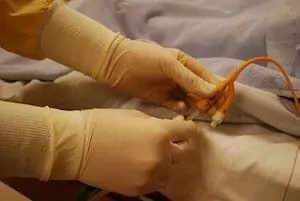If you’ve read my story about giving birth, you know I’ve had two c-sections. The first one was an emergency c-section, while the birth of my second daughter was a completely planned c-section.
Some women get pregnant and know from that moment that they would instead go through a scheduled c-section. Other women plan for vaginal delivery only to find themselves in a situation that requires no other alternative than to get a c-section. And still, others will go through almost their entire pregnancies with plans to deliver vaginally only to be told that their baby is in the breech position, and they’ll need to make plans for that c-section.
I’m with you for the reason you’re planning a c-section. Keep reading, and I’ll help guide you through some critical information to make your c-section as easy as possible.
Medical Reasons for Scheduled C-section
Medically speaking, there are a few reasons why you might be planning a c-section.
Pregnancy complications
In most cases for planned c-sections, there’s a complication with the pregnancy that would have your doctor suggest it. This doesn’t mean, though, that you should feel bad if you decide – even if there is nothing wrong with your pregnancy – to have a c-section delivery. You do you, girl!
If you have had a c-section before with previous children, you have a higher risk for complications with any consecutive pregnancies. You may be eligible to have a VBAC (vaginal birth after c-section), but you don’t have to choose it if you don’t want to. My doctor asked me if I’d like to try that option with my second daughter, and I refused.
Why?
In my situation, the labor, the dilating stall, and all the insanity (please, read my post on that whole hot mess) made me completely unwilling to go through that again. Even though I had a fantastic doctor and trusted her capabilities, I was not convinced that my body would act accordingly and make way for a vaginal delivery.
Certain diseases or conditions might make it risky for you and/or your baby if you try to deliver vaginally. These could include things like genital herpes or HIV, which would be passed along to your baby if you went for a vaginal birth. Diabetes and high blood pressure can also be problematic for vaginal deliveries, which is why you’ll likely need to plan your c-section in those instances.
Baby complications
And the other side of medical reasons for having a c-section will revolve around your baby. Or babies.
Scheduled c-sections for twins (or triplets…or more) are very common. If you’ve had your heart set on delivery vaginally, you can plan your c-section and try to deliver vaginally in the operating room. My breastfeeding coach, Vivien, did this with her twin boys.
The doctor wanted to have her ready for a c-section just in case. She did manage to deliver vaginally, but I’ve had other friends with multiples that had to take the c-section and were glad they planned for it.
Even if you’re not having multiples, if your baby is on the large side, a c-section might be the best plan. And no matter the size, as I mentioned above, if your baby isn’t in the right position (see my post on that), it’s a sage idea to get a planned c-section ready to go for the safety of your baby.
You don’t need a medical reason to schedule a c-section.
I’m telling you this right now because I don’t want you to feel like you have to do a vaginal delivery if you don’t want to. You’re becoming a mom and whatever works best for you to bring your baby into the world is what you should do.
I will say this, though…you should plan your c-section for no earlier than the 39th week.
The reason is that there’s a little uncertainty about the exact date of conception. So if you plan it too early, you run the risk of having a preemie and the whole NICU experience.
Wondering if you can choose your c-section delivery date?
Yes, you can, with some limitations. Your doctor will likely give you a week (that 39th week) where you can pick a date. It’s generally one week before your expected due date. Most doctors will accommodate your wishes if it’s medically possible to do so.
There are certainly times when you’d like to avoid a specific date, like February 29th, for example (though my friend Franny’s son was born vaginally on a leap year, and she loves it). It should be doable if your doctor is fine with the date you choose.
Going into labor before a scheduled c-section
And there are other times when you have a planned c-section and go into labor. Like I did for my youngest. She was born in my 38th week, just like my eldest. She was full-term and completely healthy. I think she just wanted to get out of there.

I had my planned c-section ready to go but was having contractions. I knew it, too, because I felt those familiar pains I recalled from having my first baby. It was late at night, and I watched the clock and spotted the pattern in timing. I waited until morning to go to the hospital. I was not exactly in a hurry to get into one of those awful hospital beds. I knew I’d likely have to wait until my doctor got to the hospital in the morning for her shift.
As soon as she saw me, she asked the nurse to run some vitals, and then I doubled over with contractions. Then she barked at everyone in Chinese to get me prepped for surgery. Even though it wasn’t the date we planned on, we had our plan ready to go.
What to expect with a scheduled c-section?
If reading my blog has taught you anything at all, you’ll know that sometimes your best-laid plans need to change on a dime. So schedule your c-section, but do be prepared that your date could suddenly change as mine did.
Most c-sections are scheduled in the morning or during daytime hours.
I honestly can’t recall when my doctor and I had scheduled the surgery with my second daughter. All I know is that by the time I got to the hospital and into the OR, my daughter was delivered just after 11 am. Fascinating stuff because it was about the same time of day as my first daughter had been born just over three years before.
Hospitals are always well-staffed, so if you have contractions before your scheduled surgery, you can feel completely at ease. There will be plenty of competent people there to care for you. As far as the scheduling goes through, you’ll likely be put on for anywhere from 8 am to early afternoon as that is more convenient for you to come in.
Preparing for a scheduled c section
So you’ve made your appointment, and now it’s a waiting game until the finish line. You’ve likely got many questions about how to prepare for your c-section and what happens during it.
It will feel MUCH longer than it takes. The entire procedure usually takes about 20 minutes, but all told, it could be a total of 45 minutes to an hour to finish up the process. That’s because you’ll need to be stitched back up.
During my first c-section, since it was an emergency, I was mostly knocked out. I knew I was having a baby and understood it was her when she let out her first cry. But other than that, it was a wild ride akin to my old college days.
I didn’t want to be so hopped up for my second one. I only wanted the necessary anesthesia to prevent feeling the procedure. An anesthesiologist was sitting right next to me, talking to me in broken English the entire time, letting me know that if I changed my mind and wanted to go under, she would take me there.
Important read: Difference between planned and emergency c-sections.
Anyway, enough about me. Let’s talk about planning your c-section. Here’s the process and what will happen once it’s go-time.
Make your scheduled c-section birth plan
When you decide to be delivered via c-section, you should sit with your doctor and husband and hash out the details. In China, my husband was not allowed in the OR during my c-section. In America, though, it depends on the hospital’s policies.
Some hospitals may allow your husband (or another relative) to be with you during the c-section, and others may not. Finding out beforehand will make things much less complicated.
Additionally, this is when you’ll want to make known your wishes. If you’re going to be put under, you’ll request this in advance. You can also choose to say no to that but have an anesthesiologist ready with the fun stuff if you change your mind during the surgery.
Also, don’t forget to clarify in your birth plan that you want to breastfeed your baby as soon as possible after your surgery.
While you’re making your birth plan, get all the forms you need for the hospital ready to go. Nothing is worse than being handed paperwork when you’re on a gurney.
Pack the right stuff in your hospital bag
As with vaginal delivery, packing your hospital bag is essential even when you plan your c-section. I recently wrote about the clothing you should wear after your surgery, so take a look at that to see what other things to bring.
Additionally, you should consider what will make you feel more comfortable and more at home. You’ll be in bed for a day or two before that catheter comes out. The best thing I had in China was a pair of slip-on sandals or slippers. I think I mentioned how the bathrooms there serve as the full shower. The floors get slippery. I was super happy to have them because they kept me from slipping once I did start walking.
If you forget something you need, don’t freak out. Your husband or a relative can always go and get it for you. This is the least of your worries.
Prepare the night before your planned c-section
You’ll most likely be told to avoid eating or drinking (even water!) after midnight. No candy or gum either. You can brush your teeth in the morning, but that’s about it. Showering first is a good idea. You won’t be able to take one for a day or two (maybe more, depending on your situation), so take your time and enjoy the feeling.
Please note that:
Don’t worry about that hair down there by the way. It will be clipped by hospital staff if need be. And if you think that’s embarrassing, just remember that these people do this every day and are not judging you for how well groomed you are down there or not!
What happens next to prep you for your c-section
Once it’s go-time, certain things will happen. It depends upon the hospital, but this is the basic rundown of how things will go down:
- You’ll arrive and check into the hospital
- You’ll change into your hospital gown
- You’ll provide a urine sample
- You’ll be connected to an IV
- Blood will be drawn, and vitals will be taken
- Hair around the area will be clipped and removed
- The anesthesiologist may ask you about your preferences or confirm those you have listed in your birth plan
- Your doctor will ask you if you have any questions and do a quick once over before beginning
And then, it’s time to start the surgery. You’ll be hooked up to monitors to measure your pulse, blood pressure, and respiration. As all this goes on, you’ll be given anesthesia. Even if you’ve elected not to go fully under, you will need to be numbed. I remember my doctor poking me with something a bit pointy and asking if I could feel it. Once she knew I felt nothing anymore, the catheter was inserted.
Honestly, a catheter sounds horrible, but your bladder needs to stay empty during the procedure. The worst part is getting it out. Once you’re numbed, you won’t feel that catheter.

After the catheter goes in, your abdominal area will be cleansed again to keep any errant bacteria away. A sterile drape will be placed over you so that you won’t see anything even if you’re awake during the surgery. If your hospital allows your husband or a relative in with you, they will sit on the same side of that drape. This is to keep them from fainting at the sight of the surgery.
Once everything is in place, your doctor will begin with an incision through your abdominal wall. Depending on your doctor, you may be given a vertical or transverse incision. Both of mine were transverse, which is also known as a bikini incision. It is one of the least noticeable incision marks and is covered up by any two-piece swimsuit on the planet. If your doctor is very adept at stitching you up, your scar will fade away after a few years, and you won’t be able to see it.
When the incisions are made, your doctor will take the baby out and then cut the umbilical cord. Your placenta will also be removed, a nice bonus since those who deliver vaginally have to push that out themselves after the baby.
You may have noticed another nurse or two enter the OR at some point. These pediatric nurses will take care of your baby once she’s removed from you. If your husband or a family member has been permitted to be there with you, they will go with the baby to the nursery for cleanup and vitals. Then they’ll meet you in your hospital room.
When the whole thing is over, your vitals will all be retaken and monitored for a short while afterward. Don’t be alarmed if you are connected to an oxygen tube. In some hospitals, this is standard to ensure proper blood flow and circulation post-surgery.
And yes, this is the glorious time when you get to meet that tiny little person who’s been kicking you and giving you heartburn. Everything you’ve just been through melts away when you are handed your baby.
Scheduled c-section recovery
As I’ve written, recovery after a c-section takes a bit longer than that of vaginal birth. It’s major surgery, so you should take it easy. Focus on resting and breastfeeding your baby. Let your husband and your other relatives and friends take care of everything else.
Don’t try to do it all. It’s so important to follow your doctor’s orders and get the rest you need. You’ll likely be given pain meds to help you out the first week or so. Your abdominal pain will subside after about 4 to 6 weeks. You can wear special compression wraps to help ease the pains and encourage your uterus to get back to size.
Make sure you read my post about those post-c-section clothes! It will help you find what you need to be comfortable during this recovery period!
What is More Painful…C-section or Natural birth?
Any way you slice it, pardon the pun; if you get pregnant and go on to have the baby, it needs to come out of you one way or another. You can either deliver vaginally or have a c-section. The choice is up to you, though sometimes, you aren’t given a choice. Then it comes down to the safest way to bring your baby into the world.
So some of you will be told toward the end that, hey, you’re not going to be able to deliver naturally. And while that might be disappointing, it does have its advantages.
Which one is more painful
Some friends of mine did water births and swore by them as not being painful. I’m not them, so I’ll have to take their word for it.
For a c-section, there is no pain during the procedure. I can tell you I felt all kinds of horrible when I was trying to deliver my eldest naturally. My epidural failed to help me because she’d turned around inside me. It was insane pain. I didn’t stop feeling pain until they wheeled me into the OR, numbed me up, and then put me under. The pain returns after the surgery and lasts for several weeks, but pain meds make it much easier to take.
Friends who have delivered the natural way have had to endure episiotomies and vaginal soreness. True that their recovery time was a bit shorter, but I think both ways of giving birth will cause some pain.
None of it matters in the end
Nope! None of it! Because however, you bring that baby into the world, it’s a beautiful thing. And it’s worth every bit of pain and agony you go through.
Leslie Berry lives with her husband and two young daughters in Los Altos, California, where she loves helping other moms get comfortable with motherhood and embracing the insanity with facts peppered with laughs.
She loves eating too much sushi, exercising, and jamming out on her Fender. Read more about Leslie here.






